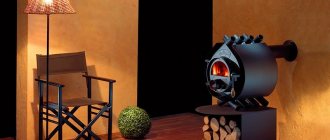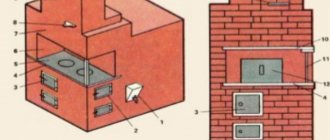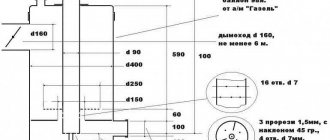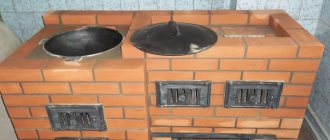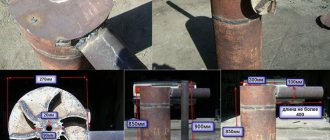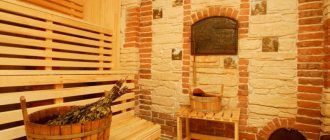Externally, the Buleryan stove resembles a potbelly stove with a fancy design. But the efficiency of this device is much higher, and the scope of application is wider.
Industrial production models are quite popular, but by making a Buleryan stove with your own hands, you can provide heat for a garage, outbuilding, or even a small house. Agree, the idea is interesting, and the savings on purchasing a new unit are quite noticeable.
In the prepared article you will find all the necessary information for constructing a heating unit. We will tell you how the Buleryan stove works and works, describe what materials and tools will be needed during the work, and also provide step-by-step instructions for making a homemade product.
In addition, the article provides practical tips on arranging a chimney and maintaining a heating installation. By following our recommendations, you can organize efficient and safe heating of a small room.
Advantages and disadvantages of the Canadian stove
Essentially being the same “potbelly stove,” Buleryan has a special charm and charm, doesn’t it?
The specifics of using the Buleryan stove initially required compliance with several mandatory requirements, which subsequently made the unit famous throughout the world. The design of the heating device had to ensure:
- Mobility. Since cutting down trees involves constant movement through the forest, the logger’s stove is constantly transported from one place to another, and from transport to room is carried by hand.
- Compactness. The unit must have a configuration and dimensions that make it possible to install the device in small temporary buildings.
- Safety. Since the operation of a buleryan involves installing a heating device directly in a residential area, its design must exclude the possibility of carbon monoxide leakage. This was made possible due to the sealed working chamber and the decision in favor of a single-door design. Another important plus is that the configuration of the body prevents the body of the furnace from accidentally touching the hot metal.
- Performance. Using forced convection makes it possible to warm up a room in record time. This condition is met thanks to a system of channels that accelerate air exchange.
- Possibility of long-term work. The configuration of the working area and the design of the blower allows the Buleryan to work for several hours from one load of fuel, and firewood, bark, chips, shavings, etc. can be used as fuel. It is not recommended to heat the stove with coal, since due to the high combustion temperature of this fuel, metal the housing overheats and becomes deformed. As a result, the geometry of the device is distorted, the combustion door does not close, and cracks in the places of welded joints.
It is quite easy to circumvent the manufacturers' ban on the use of high-temperature fuel. To do this, it is enough to equip the lower part of the heat exchangers with a manifold and supply air using any blower. Accelerating heat transfer will reduce the temperature of the buleryan to a safe level.
- Simplicity and reliability. When developing the design of the solid fuel unit, engineers took into account that it would be operated in places remote from civilization. To manufacture or repair a Canadian potbelly stove, no special equipment or expensive materials are required, and for a beginner to operate the stove, a little instruction is sufficient.
As you can see, the advantages of Buleryan were incorporated into the design at the design stage. Perhaps the developers had no idea that their brainchild would become so popular and would be used both in everyday life and in production. Of course, like any other design, a convection oven of this type is not without some disadvantages. First of all, the unit achieves its declared performance only when using absolutely dry firewood. When the fuel humidity is more than 10%, the released water vapor prevents the flow of air and reduces the combustion intensity, which leads to a decrease in efficiency. In addition, like any potbelly stove, the Buleryan does not retain heat at all - as soon as the fuel burns out, the temperature in the room begins to drop.
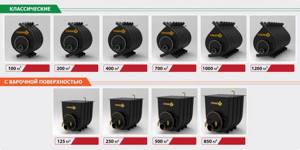
The model range of Buleryan type furnaces contains many types, differing in power and configuration
The disadvantages of the design include the fact that the operation of the stove assumes a gas-generating mode of operation, in which the wood smolders more than it burns. This process is accompanied by increased smoke formation, which leads to the release of harmful substances and tar deposits in the smoke channel. Often the outer part of the chimney and nearby areas of the roof are covered with an oily substance, which does not add any attractiveness to the picture. It is also important that when installing a stove, additional requirements are put forward for thermal insulation and the height of the chimney, otherwise the efficiency of its operation will be reduced.
As you can see, the unit is not without its shortcomings, which both the developers and the owners honestly point out. Nevertheless, the numerous advantages of Buleryan have made this heater one of the most popular units on the market of compact solid fuel equipment.
Classic stove design
In order to make a homemade unit, you should carefully understand its design and understand the principle of operation. An all-metal product consists of a minimum number of elements. The basis of the furnace is a cylindrical firebox with curved metal tubes tightly adjacent to its walls. On the front side there is a door for loading fuel and a device that allows you to regulate power and set different combustion modes. In the firebox itself there is a secondary combustion chamber and an outlet pipe to which the chimney is connected.
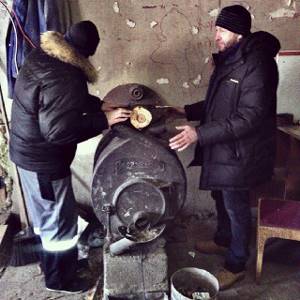
To increase the efficiency of such a furnace, it is imperative to ensure high-quality thermal insulation of the smoke channel. Ordinary mineral wool is perfect for this (a layer of ≥ 3 mm is sufficient). Do not forget that to supply air to the combustion site, you should install a ash pit. It would be useful to install a small ash pan. The double rear wall also improves the efficiency of the device. A number of models have a two-layer oven body.
Varieties with photos and geography of use of buleryan
In order to understand the difference between buleryan, breneran, buller, Butakov oven and other types of convection ovens, let’s take a closer look at all the nuances. First of all, o is a brand of the German company Bulerjan, which produces super-bourgeois stoves. Ovens of this type are often called the shorter word buller. “Breneran” are the same units, but produced by domestic factories under license. The furnace developed in Russia by Professor Butakov is very similar in operating principle to the original design, but has some differences:
- recessed convection heat exchangers;
- cubic body shape instead of cylindrical;
- the use of an ash pan and grate;
- flat platform at the top of the cabinet for heating food.
In fact, the use of a grate in a gas-generating unit is unnecessary, since intensive burning of wood is expected only in the first minutes after ignition. In addition, its purpose is unclear, given that it is located below the level of the blower. There are also doubts about the effectiveness of the platform for installing a pot or kettle. When entering operating mode, the temperature of the buleryan rarely reaches even 75 ° C, so it will take a lot of time to warm up the food.
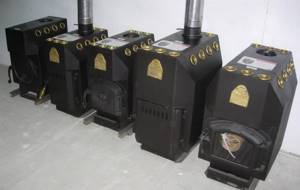
Butakov's stove is a modernized Buleryan
Despite the fact that the heating device was originally designed as a stove with an air heat exchanger, some craftsmen loop convection channels by connecting them to a water heating system. The resulting aquabuller, of course, has the right to exist, but the feasibility of such a solution is questionable. Firstly, the heat capacity of air is 800 times less than that of water, so a furnace designed for convection will operate with reduced efficiency under liquid heat exchange conditions. Secondly, even if we take Breneran as a long-burning unit, this is also irrational, since there are more suitable specialized designs of solid fuel boilers that use pyrolysis. Despite this, aquabullers have found their place in the line of units, which are a modernized buleryan.
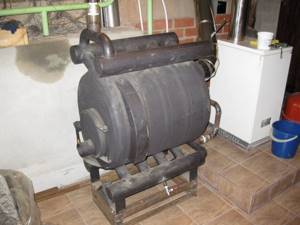
The water jacket turns the convection oven into a water heating boiler, which is called an aquabuller
To retain heat from a potbelly stove longer, owners use various heat-storing devices that are installed on convection pipes. In addition, buleryans are often wrapped in brickwork, creating a kind of fireplace with holes for warm air to escape on the sides. This option looks good in a country house. According to the owners, the symbiosis of the buller with a brick stove allows you to keep the room warm for up to 8 hours, which is quite enough for comfortable living in the winter.
Despite the fact that the calorific furnace was originally developed for domestic use, currently buleryan is widely used in all areas of economic activity:
- for heating dachas and country houses, including wooden ones;
- in production workshops;
- for heating utility rooms;
- in garages and workshops;
- in baths and saunas;
- to maintain the required temperature in greenhouses;
- as heating units for country cafes and restaurants;
- for heating administrative buildings in rural areas, etc.
The classic buleryan stove is not suitable for heating tents.
When installing a buleryan, be sure to take into account the power and dimensions of the heating unit, since this determines whether the device can evenly heat the entire room. It is equally important to choose the right place to install the Canadian stove, equip the chimney according to all the rules and ensure its regular maintenance.
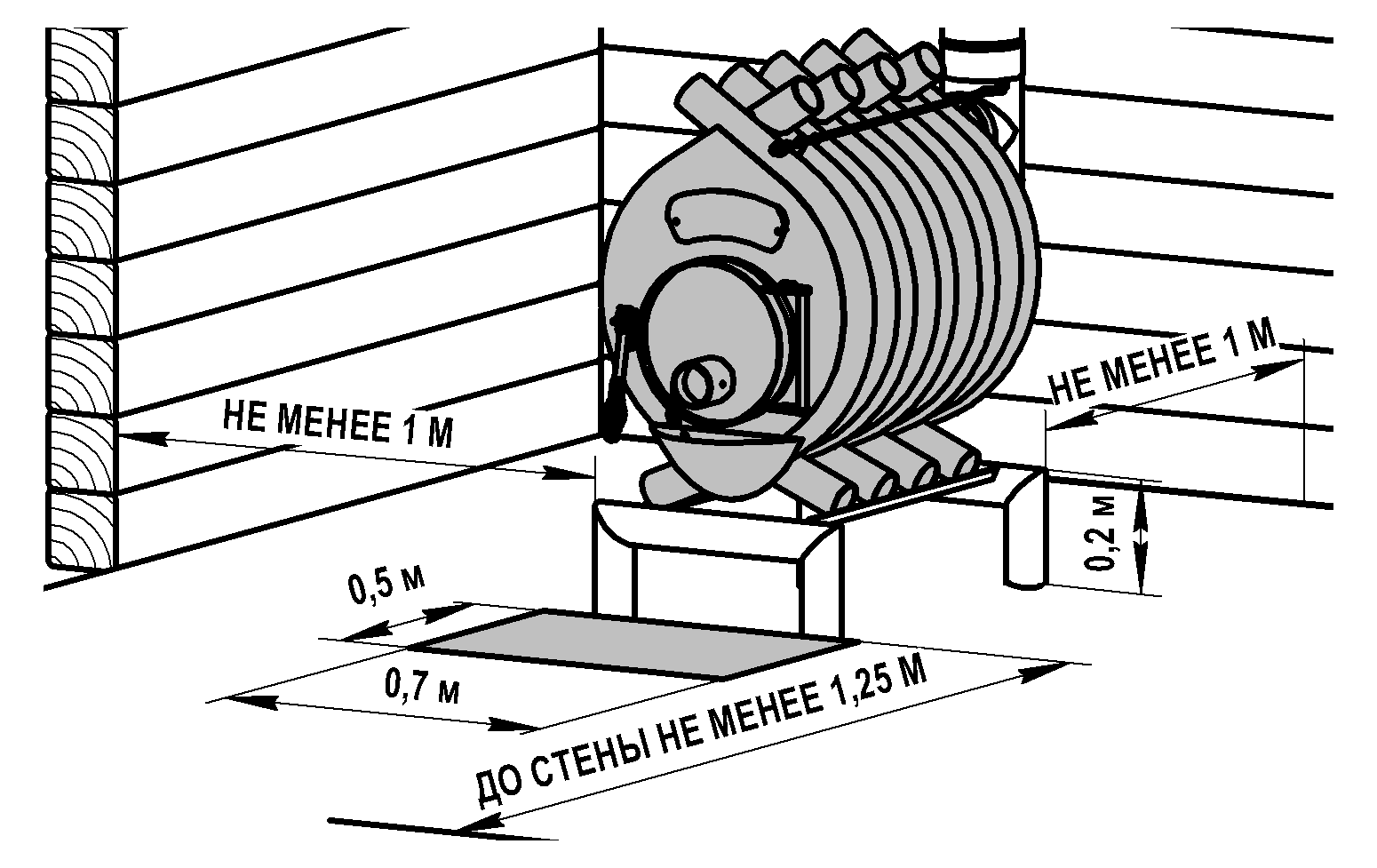
Convection unit installation diagram
Installation features
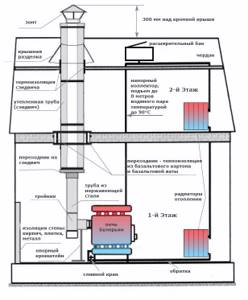
General connection diagram with description
Fire safety
For any room where the stove will be located, it is necessary to comply with fire safety standards:
- The structure can only be placed on a non-combustible base; steel sheets or a concrete floor are perfect for this.
- A sheet of steel must be laid on the floor near the firebox, the length of which must be at least 1.25 m.
- The distance from the wall to the stove should not exceed 1 meter for plastered surfaces and 80 cm for surfaces with an insulation layer.
- The stove can be installed in a room with excellent ventilation and an area of 12 sq.m. machines for heating elements are installed only in adjacent rooms.
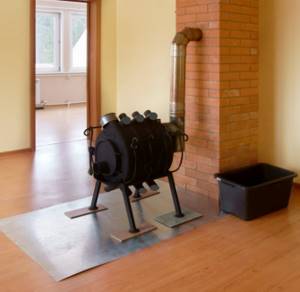
Correctly installed Buleryan stove according to PPB rules
Installation of a smoke removal system
When installing a chimney, the following requirements must be met:
- materials that are resistant to corrosion, high temperatures, and acids are used;
- the chimney pipe inside must be perfectly smooth;
- The layer of the pipe facing the street is insulated with basalt wool, the thickness of which will be at least 50 cm.
All chimneys are installed vertically; the length of the pipe outlet from the stove to the common chimney cannot be more than 1 meter.
Gravity system
When connecting Buleryan with a water jacket to a natural heating circuit, the following recommendations must be observed:
- The wood-burning stove is placed 50 cm lower than the radiators are installed;
- pipes are mounted at an angle;
- an expansion tank is placed at the highest point (usually in the attic);
- for unheated attics, the installation site of the expansion tank should be insulated;
- supply pipes require a special safety circuit.
Forced circulation
A Buleryan stove with a water circuit is installed together with an additional pump. The scheme includes:
- a circulation pump is installed on the return line;
- Thermal sensors are used for adjustment;
- the circuit requires a closed expansion tank;
- To operate the pump, you must install a UPS with a voltage stabilizer.
Pipes for piping
Various pipes are used for Buleryan, but their choice should be taken responsibly, since they have a great influence on performance. Three types of pipes are recommended for piping Buleryan:
- metal-plastic, corrosion-resistant and easy to install (can be used with forced-air heating systems only for industrial enterprises);
- polypropylene pipes can be easily installed with your own hands, they are inexpensive, lightweight, and easy to install (allowed for installation in residential buildings);
- steel pipes can withstand high temperatures for a long time (can be used for any Buleryan, but require a system of greater power than a circuit with plastic pipes).
Design features and principle of operation
When developing Brenaran, Canadian specialists used the long-known design of a long-burning convection boiler, called a calorific furnace. Thanks to the increase in the combustion door, it became possible to load not only chopped logs, but also parts of rhizomes, as well as large logs. The new form of the blower - in the form of a pipe embedded in the loading hatch - made it possible to abandon the two-door design. To regulate the amount of air required for fuel combustion, a throttle was installed inside the blower - a round rotary valve. The external throttle control lever allows, if necessary, to reduce or increase the air flow, thereby controlling the power of the buleryan.
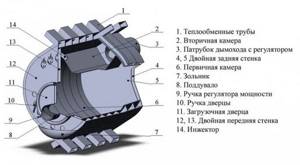
Buleryan design
The firebox of the heating unit is a metal cylinder, on both sides of which tubular metal heat exchangers, bent in the form of elbows, are embedded at equal intervals. Due to the fact that two-thirds of the diameter of the pipes are recessed into the body of the stove and are located in the combustion zone, the air receives up to 70% of the heat that is released when burning wood. The remaining kilocalories heat the body of the stove and are subsequently also spent on heating the room. Thanks to this distribution, the body of the buleryan usually heats up to only 60–65 °C, while the air that leaves the convection channels has a temperature of more than 100 °C. It must be said that it is the high heating rate that ensures the active suction of cold air masses in the lower part of the tubular heat exchangers and their release from the upper openings of the heater.
The combustion space inside the device is divided into three chambers. A metal under or removable grate is installed in the lower part of the furnace at a height of up to ¼ of the body diameter. You can do without these elements, but with them it will be easier to light the stove and remove ash. Under the arch of the firebox, at the same distance from the body as underneath, a perforated metal sheet is welded, which does not reach the loading hatch a quarter of the length of the buleryan. The upper chamber is designed for afterburning volatile compounds that are released when the unit operates in gas generator mode.
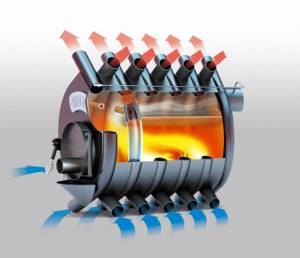
Rapid heating of the air is ensured by convection heat exchangers that make up the core of the furnace
The combustion products are removed through a hole located in the afterburner chamber, on the side of the rear wall of the unit. A damper with a 90-degree sector cut out is mounted at the beginning of the smoke channel. In addition, around the damper (a metal plate that regulates chimney draft) there is a gap of at least 10–15% of the chimney diameter. This design makes it possible to set the correct draft and at the same time does not allow carbon monoxide to enter the room, even if the smoke channel is completely blocked during intense gas formation.
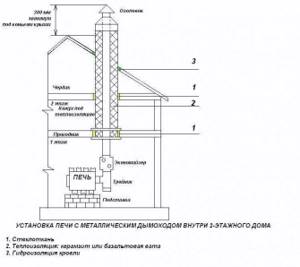
Increased demands are placed on the buller chimney
A horizontal section of the chimney, designed to reduce the temperature of combustion products, extends from the outlet opening, and then an elbow is installed that directs the pipe vertically. Here, “real” units manufactured by Bulerjan are equipped with a device for pyrolysis combustion of gases, called an economizer. The chimney must be high enough to obtain high-quality draft and insulated so as not to allow the combustion products to cool too much. If this requirement is not met, as well as when using fuel with a high moisture content, the temperature in the afterburning chamber will be reduced, as a result of which the content of tar and other unsafe carbon compounds in the flue gases will increase.
Manufacturing options
Today, two options for manufacturing the Buleryan stove are known, based on the materials they are made from: from profile and curved pipes or from a gas cylinder. Each type of system has its own efficiency and varies in implementation complexity:
- From a profile pipe. The Buleryan system made from a profile pipe is a simple design that provides efficient heating of small spaces: a garage, greenhouse, barn or small gym. The stove is easy to manufacture and can be made by any welder from scrap materials.
- From a gas cylinder. Due to the fact that almost every private yard has an old gas cylinder, this type of stove is made quite often. An excellent solution for a country house or garage, and thanks to the shape of the cylinder, it becomes possible to implement interesting design ideas.
The Buleryan stove is easy to make with your own hands, no matter what type you decide to make yourself. The choice depends on the capabilities of the master, the availability of material and the skills of the owner.
Drawings and diagrams of buleryan for making it yourself
Despite the fact that manufacturers keep the exact parameters and drawings of the convection ovens they produce secret, taking dimensions from the finished product is not difficult. Thanks to passionate people, today we have an almost complete set of design documentation. It must be said that when making a buleryan it is important to observe the ratio of the sizes of all parts of the unit, so you can adapt the drawings presented below as an example to your conditions.
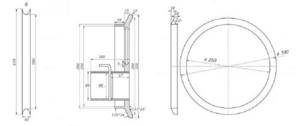
Drawing of the buleryan door
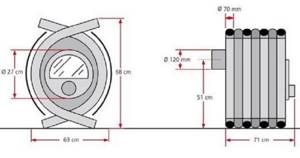
Buleryan's drawing
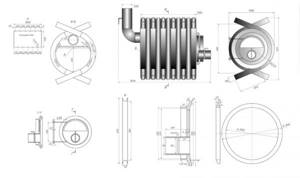
Buleryan's drawing
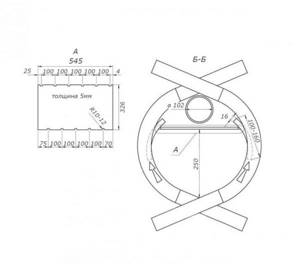
Buleryan's drawing
The process of making a homemade stove
First of all, we weld the side walls and bottom together. We set the grates at a distance of 70 mm from the bottom. To support the grate bars, square rods must be welded to the walls.
You can also weld square rods on top of the grate bars to the side walls of the boiler to securely fix them inside the fuel chamber.
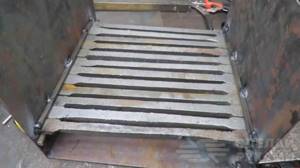
It is important that there is a small gap between the grates themselves, as well as between the grates and the upper square bar. Otherwise, when they expand, they can “break” the welds.
What you need to make a Breneran type convection oven
In order to get a truly reliable and durable heating unit, it is made of thick metal. The best material is considered to be heat-resistant boiler steel, which can be purchased at specialized offices. Before starting work, prepare:
- rolled steel sheets with a thickness of at least 5 mm, size 1000x2000 mm;
- sheet of heat-resistant steel 6 mm thick, 400 mm wide and 700 mm long;
- a small piece of steel sheet 3–4 mm thick for making valves;
- steel pipe Ø110 mm - 4 meters;
- round thick-walled pipe Ø57 mm or profile metal pipe with a thickness of 4 mm and dimensions of at least 60x60 mm - more than 10 m;
- steel tube Ø15 mm - 40 cm;
- rings for the door, cut from a pipe Ø350 mm;
- powerful loops for fastening the loading hatch;
- handle with a locking mechanism for the door;
- pieces of steel rod Ø8 mm for the manufacture of air and smoke damper levers;
- asbestos cord.
Often, zealous owners use cylinders or metal barrels to make furnace parts, but the materials from which they are made are not always suitable for the needs that they are going to satisfy with the help of such a homemade product.
Tools and devices that will be needed in the process of making a Canadian stove:
- powerful pipe bender;
- welding machine;
- angle grinder (grinder);
- cutting and cleaning discs;
- electric drill and set of drills for working on metal;
- hammer;
- roulette.
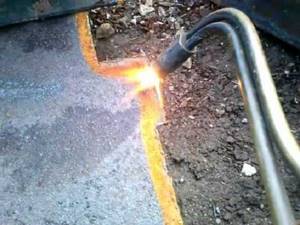
Precisely configured parts can be obtained by cutting a thick sheet of metal with a cutting torch
If possible, it is better to cut the metal sheet with a gas cutter or other special equipment. Firstly, this will save more than one cutting disc for an angle grinder, and secondly, after the gas cutter, the round body parts will only require a little grinding of the edges. If you use an angle grinder, you will need to put a lot of effort into turning the polygons cut out with it into circles.
Buleryan from a gas cylinder
You can simplify the manufacturing process if you use an old gas cylinder as the main combustion chamber:
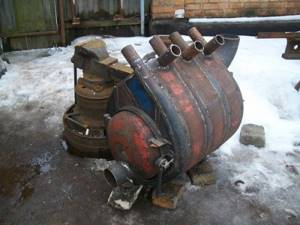
Gas cylinder construction
If you understand the meaning of the operation of a long-burning fuel stove, then in the manufacture of buleryans you can use not only a cylinder, but also other available materials for the production of metal structures.
Scheme and drawing, dimensions
Essentially, a homemade Buleryan stove from a gas cylinder is made in the same way as a long-term combustion stove from iron sheets, but the difference is that the main combustion chamber is already ready and does not need to be made from scratch.
The drawing above shows the design diagram in detail, indicating all dimensions. Take them into account in order to properly make a Buleryan stove with your own hands.
Materials
In addition to the gas cylinder, you will need round or profile pipes with a diameter of 80 mm and a sheet of iron to make a door 5 mm thick.
Tools
To manufacture a structure from a gas cylinder, you will need the same list of tools as in the case of assembling a structure from sheets and profiles:
- Welding machine and electrodes;
- Grinder or grinder, metal discs;
- Measuring tools – tape measure, ruler, corner;
- Pipe bender;
Step-by-step instruction
- Using an iron sheet, a suitable blank is cut out and a baffle is welded on to create a second combustion chamber.
- Then a hole is made for a pipe with a diameter of 120 mm and a chimney with that diameter is welded.
- On top of the cylinder, which is now the combustion chamber, blanks from round or profile pipes are welded, in which the air is heated.
- Then the hinges are welded and the oven door is installed.
Refinement and modernization of the heating device
The design of the Canadian stove is designed to heat one room, since walls and partitions create a barrier to heated air flows. The installation of a metal unit in residential premises greatly affects the aesthetic value of the interior, and the need to throw firewood in the middle of the night so as not to freeze in the morning can hardly be called comfortable operation. Numerous owners of calorific furnaces are trying to solve these and other disadvantages of buleryan. And, I must say, not without success.
Distributing heat throughout the rooms of the house
In order to heat the whole house with buleryan, and not just one room, corrugated pipes are connected to the heat exchangers of the unit, which are led through the wall of the room, and the opening is ennobled with the help of a decorative grille. Of course, the ideal option is when this type of heating is considered at the building design stage. Then special channels are provided in the walls of all rooms to supply warm air. Nevertheless, even in a house built a long time ago, such a scheme can be implemented if you install a calorific furnace in the basement and run air ducts through the floor of each room on the floor. This fulfills the requirement for heat supply at the lower level and ensures ease of maintenance of the unit.
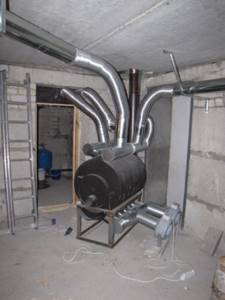
Buleryan, equipped with air ducts, will heat every room in the house
Air heating of every room in the building will require a slight improvement in the design of the buller. First of all, this concerns the air supply - natural inflow will not be enough, therefore, on the bottom side of the unit, collectors are installed on each row of heat exchangers, which will ensure the distribution of air coming from the duct fans. The same collectors are installed at the outlet of each group of air ducts. They will mix air masses coming from parts of the unit with different temperatures. Insulated corrugated pipes are connected to the output manifold, through which heat will be distributed to each room. Since the air temperature at the outlet of the heater reaches 120 °C, when laying pipes through ceilings and partitions, the conditions provided for the installation of chimneys must be observed.
Improving the appearance of the unit using brick or stone masonry
If you cover the Canadian unit with brick, you can simultaneously solve several problems:
- increase the aesthetic value of the stove in the interior;
- ensure safety during operation of the unit;
- increase the thermal capacity of the structure.
A buleryan stylized as a fireplace or Russian stove looks especially advantageous, and if in addition to this the front door is equipped with tempered heat-resistant glass, then such a unit can create a unique atmosphere of comfort and homely warmth, while also performing the main function of heating square meters.
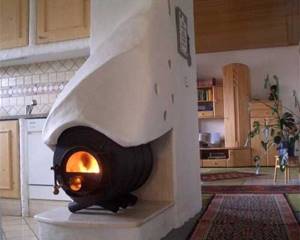
The superstructure, stylized as a Russian stove, turns the potbelly stove into an exclusive heating device
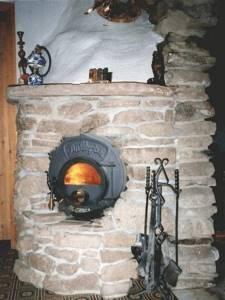
Buleryan, completely hidden in stonework
If you decide to decorate the Buleryan yourself using bricks, for example, for a bath room, then keep in mind that if the height of the loading hatch is less than 40 cm from the floor, it will be inconvenient to heat the stove, and in addition, the design of the structure will suffer. The masonry should be as close as possible to the furnace body, and the gaps between the brick and the furnace must be filled with broken bricks, which are laid on the mortar. Remember - the masonry will act as a heat accumulator, so how long the stove will remain warm depends on its solidity. We remind you that during operation you must ensure that the inlet and outlet openings of the heat exchangers are outside the “fireplace” and that no construction waste gets into the pipes. It is best to cover the heat exchange channels with a rag at this time.
Converting a potbelly stove for liquid fuel
Despite the fact that the Breneran was originally designed as a wood-burning stove, it can be converted to run on diesel fuel or on cheaper fuel - waste motor oil. Of course, this heating method is not suitable for a living space, but it is suitable for long-term heating of a garage or utility room.
To transfer Buleryan for testing you will need:
- place an oil container on a slight elevation;
- extend the liquid fuel supply hose to the unit;
- cut a hole in the combustion door for the tube to which the fuel supply control valve is connected.
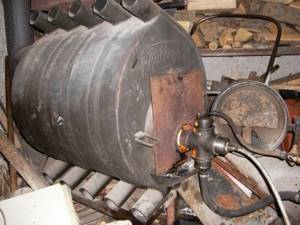
In order to convert a buleryan to function in mining, it is enough to install an oil container and a special burner
When using used oil, it is important to ensure good traction and correctly regulate the fuel supply. Sometimes, instead of a homemade dropper, a factory burner specially designed for this type of fuel is installed on the hatch. Unlike a home-made device, an industrial nozzle ensures more complete combustion of waste.
Water circuit installation
As noted earlier, inquisitive minds have more than once modified the classic Buleryan to work in a liquid heating system. At the early stages, DIYers tried to loop all the heat exchangers into one circuit. The result was a coil, through which water circulated thanks to the use of a centrifugal pump. Later, a scheme was proposed that was similar to the previously described design for upgrading the unit to distribute air flow throughout all rooms in the house. The upper and lower sections of the heat exchangers were welded into cylindrical collectors, connecting the lower element to the return line, and the upper element to the supply pipeline. Thus, it became possible to install the unit not only in heating systems with forced supply of coolant, but also when using natural circulation of liquid. By the way, the disadvantage of buleryan, associated with the impossibility of working on high-temperature fuel such as coal, is eliminated by itself - thanks to its high heat capacity, water does an excellent job of cooling the walls of the unit.

Buleryan with a continuous water jacket
As for making buleryan “from scratch,” the process is even simpler. Instead of making a frame from heat exchanger pipes, the body of the furnace is made entirely of sheet steel, resulting in a unit of the correct cylindrical shape. On top, the structure is wrapped in another cylinder, which serves as a water jacket. Since the lower part of the potbelly stove heats up weakly, the stove must be moved downwards relative to the casing. In order to make the most of all the heat, some craftsmen manage to install a water circuit at the exit of the smoke channel. In the photographs you can see all the nuances of the described metamorphoses.

Shifting the furnace body down relative to the water jacket allows water to be heated more efficiently
If we take into account that pyrolysis combustion of exhaust gases should occur in the vertical channel at the outlet of the buleryan, cooling this section of the chimney contradicts the very principle of operation of the stove, and therefore is hardly correct.
Brick heating structures
The main advantage that stone stoves for summer cottages can boast of is their ability to retain heat for a long time. This is true when you have to stay in the building overnight on frosty days. However, it takes a long time to melt the structures, which is not very convenient for short-term use.
Relevance of application
For familiarization purposes, it is recommended to look at the rating of stoves for summer cottages to make it easier to understand them. The applicants are distributed according to their relevance in application for suburban buildings of temporary residence.
Dimensions, efficiency, manufacturing complexity and other parameters were taken into account.
Dutch - compact design.
- In first place is a Dutch oven for a summer house, as it has compact dimensions, which means it can be actively used in many rooms. Due to the presence of vertical channels, it has high thermal output.
- The second position is occupied by the Swedish brick heating structure. It can fit in almost any building, of course, if these are not country houses made from block containers.
- Third place goes to the Russian stove due to its impressive size and complexity of manufacture. This option is more suitable for residential buildings than for country houses.

Russian stove in an interesting design.
Attention! After selection and installation, a universal stove for a summer residence must be finished without fail. In the cladding process, completely different materials can be used: tiles, plaster, tiles or whitewash.
Classification of structures
Depending on the purpose, heating, cooking and combined structures are distinguished. In the first case, only heating of the premises is carried out, in the second - only cooking. In addition, the structures can be combined directly with each other.
Ovens can be classified by the thickness of their walls, which can be thin or thick. The heating and cooling time depends on their size. For a country house, it is recommended to choose thin-walled structures, since they do not require a massive foundation.
As for the configuration, the designs can be rectangular, square, corner, round and even T-shaped. The choice of shape is usually made taking into account the interior design.
Design possibilities
Using various types of finishing, the aesthetic characteristics of a brick structure can be formed. Unlike metal analogues, there are a great many options for improving external data.
If necessary, the cladding can be easily replaced, radically changing the perception of the heating structure.
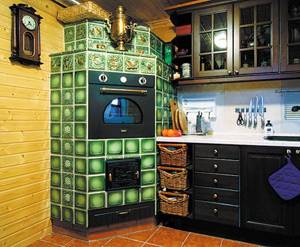
An example of using tiles for decoration.
- Facing bricks can add a touch of modernity to the appearance, which is why they are very often used for finishing. Ideal for styles that feature predominantly straight lines.
- Ceramic tiles, with their variety of colors and installation variations, can completely transform a design. Imitation of other materials, such as wood, looks interesting.
- Decorative plaster provides the opportunity to create coatings with an aesthetically attractive texture. The result is exquisite products.
- Handmade tiles allow you to create exclusive designs, which, after finishing work, act as the main source of attention.
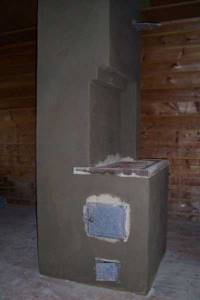
A conventionally plastered stove.
Addition! Other materials that can withstand elevated temperatures can be used as the main finishing. There are no special restrictions when carrying out cladding.
Correct operation and maintenance of the oven
To quickly light the stove, use finely chopped dry firewood, under which paper or cardboard is placed. After the wood is ignited, the main portion of fuel is added to the buleryan. It must be said that thick logs up to 40 cm long are ideal for this unit - they will give off heat for several hours. You should not warm up the stove for more than 20–30 minutes with the damper fully open - Breneran is designed to smolder fuel, so a large fire will simply carry the lion's share of the thermal energy into the chimney. In addition, a red-hot stove may warp or one of the welds may come apart.
After the wood has completely ignited, the stove is switched to gasification mode, for which the gate and throttle are closed. The operation of the unit in gas generator mode is indicated by a small flame under the roof of the fuel chamber, which accompanies the combustion process of the released gases.
The efficiency of the unit depends on how dry the firewood is. Therefore, it is recommended to dry the fuel before loading. By the way, for this you can use the heat of the melted stove itself if you place another armful of firewood on the heat exchange pipes.

The versatility of the buller is evident even when drying firewood
Smoke filling the room when a potbelly stove is lit indicates one of the following errors:
- insufficient chimney height. Excellent traction characteristics will be provided by a pipe with a height of at least 5 m, and its upper cut must be located above the roof;
- the gate valve is closed;
- deposits of condensate and soot narrowed the smoke channel so much that normal removal of combustion products became impossible. They need to be removed.
Contamination of the furnace during operation is manifested not only in deterioration of draft. Deposits on the gate prevent its normal closure, and a layer of soot on the internal surfaces of the heating unit significantly impairs heat transfer.
In order to clean buleryan, several methods are used, one of which involves burning out resins and soot. Experts do not recommend burning the unit, since this involves heating the stove and chimney to too high a temperature. In addition, the process is often accompanied by uncontrolled ignition and the release of burning residues onto the roof.
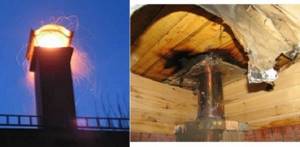
Cleaning by burning soot can be a big disaster
It is best to clean the boiler and chimney using old-fashioned methods, using metal brushes and scrapers. Dirt and oily deposits are removed from the chimney by first removing the flange at its bottom. The inner surface of the combustion chamber can be brought into proper shape using a small paint spatula or chisel.
Remember that if regular use of the buleryan requires cleaning the chimney more than twice a year, it means that the optimal operating mode of the stove has not been achieved. To ensure efficient operation of the unit, experiment with the position of the dampers, determining the position in which the fuel will burn completely.
Helpful operating tips
“Incorrect” installation of chimney pipes is due to the need to protect the structure from resin, which is formed as a result of the combustion of wood. If this moment is not provided for, then the resin will flow out of the stove, and with such an installation it will remain in the chimney and gradually burn out.
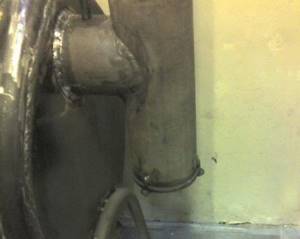
Upon completion of assembly, the Buleryan stove is installed on a flat and fire-resistant base and connected to the chimney. In this case, it is necessary to comply with fire safety rules
Clogging with resin for the Buleryan stove is almost inevitable. Over time, resinous layers accumulate and clog the device. This is expressed in a noticeable reduction in the efficiency of its operation, a decrease in traction, and problems with the free movement of the gate. So it's time to start cleaning the oven.
A lightweight version of this cleaning is to heat the device with aspen firewood. Unfortunately, the practical benefits of such a measure are small and short-lived.
The best way to eliminate resin contamination is burning. To do this, the stove is heated strongly with the ash pan open, essentially calcining all the channels. As a result, the resinous deposits burn out.
Based on the Buleryan stove, you can organize an autonomous heating system:
Image gallery
Photo from
Burelyan as the basis for autonomous heating
Air heating basis
Connecting their corrugated air ducts to the furnace pipes
Water heating device
Some craftsmen use oxygen to burn the furnace, bringing the nozzle of the cylinder to the opening of the ash pan. This is an extremely dangerous operation that violates fire safety regulations. Careless handling of an oxygen cylinder near an open flame may cause an explosion.
As fuel for the Buleryan stove, you can use not only firewood, but also wood waste (shavings) or special briquettes. An important condition is low fuel moisture. The less moisture, the less resin is formed inside the stove, and the less often it will have to be cleaned.
During operation of the furnace, you need to select an operating mode in order to obtain maximum heat with minimal resin formation. If the best option is found, cleaning will only need to be done a couple of times during the heating season.

